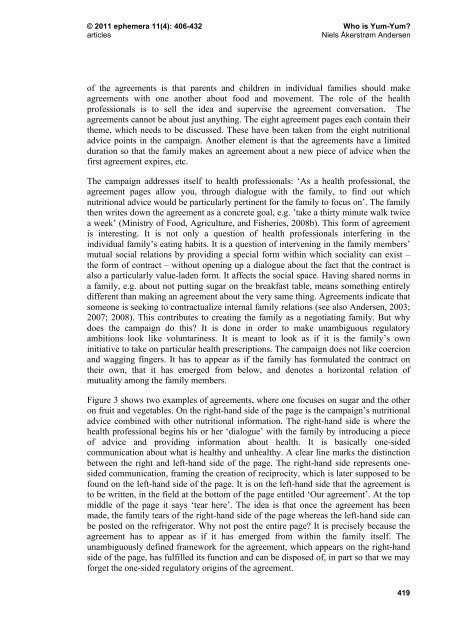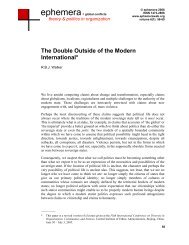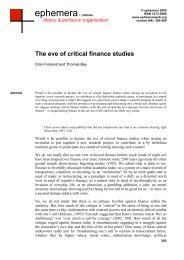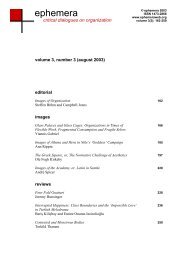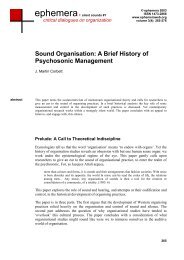Work, play and boredom - Ephemera
Work, play and boredom - Ephemera
Work, play and boredom - Ephemera
You also want an ePaper? Increase the reach of your titles
YUMPU automatically turns print PDFs into web optimized ePapers that Google loves.
© 2011 ephemera 11(4): 406-432 Who is Yum-Yum?<br />
articles Niels Åkerstrøm Andersen<br />
of the agreements is that parents <strong>and</strong> children in individual families should make<br />
agreements with one another about food <strong>and</strong> movement. The role of the health<br />
professionals is to sell the idea <strong>and</strong> supervise the agreement conversation. The<br />
agreements cannot be about just anything. The eight agreement pages each contain their<br />
theme, which needs to be discussed. These have been taken from the eight nutritional<br />
advice points in the campaign. Another element is that the agreements have a limited<br />
duration so that the family makes an agreement about a new piece of advice when the<br />
first agreement expires, etc.<br />
The campaign addresses itself to health professionals: ‘As a health professional, the<br />
agreement pages allow you, through dialogue with the family, to find out which<br />
nutritional advice would be particularly pertinent for the family to focus on’. The family<br />
then writes down the agreement as a concrete goal, e.g. ’take a thirty minute walk twice<br />
a week’ (Ministry of Food, Agriculture, <strong>and</strong> Fisheries, 2008b). This form of agreement<br />
is interesting. It is not only a question of health professionals interfering in the<br />
individual family’s eating habits. It is a question of intervening in the family members’<br />
mutual social relations by providing a special form within which sociality can exist –<br />
the form of contract – without opening up a dialogue about the fact that the contract is<br />
also a particularly value-laden form. It affects the social space. Having shared norms in<br />
a family, e.g. about not putting sugar on the breakfast table, means something entirely<br />
different than making an agreement about the very same thing. Agreements indicate that<br />
someone is seeking to contractualize internal family relations (see also Andersen, 2003;<br />
2007; 2008). This contributes to creating the family as a negotiating family. But why<br />
does the campaign do this? It is done in order to make unambiguous regulatory<br />
ambitions look like voluntariness. It is meant to look as if it is the family’s own<br />
initiative to take on particular health prescriptions. The campaign does not like coercion<br />
<strong>and</strong> wagging fingers. It has to appear as if the family has formulated the contract on<br />
their own, that it has emerged from below, <strong>and</strong> denotes a horizontal relation of<br />
mutuality among the family members.<br />
Figure 3 shows two examples of agreements, where one focuses on sugar <strong>and</strong> the other<br />
on fruit <strong>and</strong> vegetables. On the right-h<strong>and</strong> side of the page is the campaign’s nutritional<br />
advice combined with other nutritional information. The right-h<strong>and</strong> side is where the<br />
health professional begins his or her ‘dialogue’ with the family by introducing a piece<br />
of advice <strong>and</strong> providing information about health. It is basically one-sided<br />
communication about what is healthy <strong>and</strong> unhealthy. A clear line marks the distinction<br />
between the right <strong>and</strong> left-h<strong>and</strong> side of the page. The right-h<strong>and</strong> side represents onesided<br />
communication, framing the creation of reciprocity, which is later supposed to be<br />
found on the left-h<strong>and</strong> side of the page. It is on the left-h<strong>and</strong> side that the agreement is<br />
to be written, in the field at the bottom of the page entitled ‘Our agreement’. At the top<br />
middle of the page it says ‘tear here’. The idea is that once the agreement has been<br />
made, the family tears of the right-h<strong>and</strong> side of the page whereas the left-h<strong>and</strong> side can<br />
be posted on the refrigerator. Why not post the entire page? It is precisely because the<br />
agreement has to appear as if it has emerged from within the family itself. The<br />
unambiguously defined framework for the agreement, which appears on the right-h<strong>and</strong><br />
side of the page, has fulfilled its function <strong>and</strong> can be disposed of, in part so that we may<br />
forget the one-sided regulatory origins of the agreement.<br />
419


